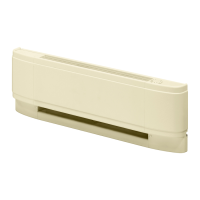7210940100R02
Linear Convector
LC Series
WARNING:
contractor.
WARNING: Wiring procedures and connections should be in accordance
with the National Electric code (NEC) and local codes.
CAUTION: Disconnect power supply before installation to prevent electric
shock.
CAUTION: Connect linear convectors to a branch circuit used only for
permanently installed linear convectors and protected by overcurrent devices
rated or set at not more than 30 amperes.
CAUTION: The total connected load should not be more then 80% of the
rating of the overcurrent devices.
PLACEMENT OF THE LINEAR CONVECTOR
For maximum comfort heating the linear convectors should be installed against an
outside wall and below a window or as close as possible to the window. Linear
convector may only be surface mounted on plaster, wood or concrete wall and
oriented horizontally with the topside up. (See Figure 6)
RECOMMENDATIONS FOR LOCATING DRAPES AND FURNITURE
NEAR LINEAR CONVECTORS (FIGURE 7)
For most satisfactory operation of the linear convectors and minimum effect on drapes
and furniture, the following recommendations should be observed:
Hang drapes so that, in use, they extend below the center line of the linear 1.
-
ing (such as carpet, if used).
Hang drapes so that there is at least 3 inches between the extreme front of the 2.
linear convector and the nearest fold of the drapes in the folded back (opened
drape) position.
Hang drapes so there is at least 1.5 inches between the top of the drapes and 3.
the ceiling.
To be suitable for draperies located close to linear convectors, material should 4.
not discolour nor distort dimensionally (stretch or shrink) upon extended expo-
sure (1000 hrs.) to a temperature of 200º F (93º C).
!
NOTE: If drapes are to be cut off above a linear convector, they should be cut
off at least 6 inches above the top of the linear convector and preferably more.
!
NOTE: Place furniture no closer then 3 inches from the linear convector.
FACTORY WIRING OF THE LINEAR CONVECTORS
All linear convectors have provisions for connection to either end of the linear
convector. The lead wires at either end are factory spliced with wire nuts as
closed circuit. The circuit may be opened at either wire nut connection to make
connections to the power supply and/or to the desired controls. (See Wiring
Diagrams)
CONTROLS (not included)
A thermostat control (wall mounted or built-in) is required to operate this unit.
Typical Dimplex controls:
Built-in thermostat kits: DTK-SP, DTK-DP, DTKT-SP or DTKT-DP
External line voltage thermostats: TSxx or TDxx
Built-in low voltage relay: BLLVCxx or BLLVD
INSTALLATION WITH NON METALIC CABLE TYPE NMD (LOOMEX)
1.
Remove front cover as shown at the end to be connected. Remove wire nut and
separate the baseboard leads. (Figure 1 & 3)
Insert wire through hit-lock connector, as shown, and connect to linear convector 2.
lead wires. Additional wire nut is required. Connect grounding wire to ground-
ing method provided. Place wires in linear convector and replace front cover.
(Figure 2 & 4)
Push cable back into wall as linear convector is being positioned against wall. 3.
covering, raise linear convector accordingly. (Figure 5)
With linear convector in position, run screws through pre-selected mounting holes. 4.
Screw should be backed off 1/2 turn from snug position to allow free expansion
and contraction of housing and to insure quiet operation. (Figure 6)
INSTALLATION WITH RIGID OR E.M.T. CONDUIT OR BX CABLE
Remove screw holding the end cover and remove the cover. (Figure 10)1.
2.
(Figure 10)
Make electrical connections in the connection box. Replace covers and secure 3.
baseboard in position. (Figure 8)
CONNECTING MULTIPLE LINEAR CONVECTORS TOGETHER
The linear convectors can be connected end to end to form a continuous length
of linear convector section. When units are installed end to end, join the linear
convectors to ensure ground continuity between.
Installation Instructions
IMPORTANT INSTRUCTIONS
When using electrical appliances, basic precautions should always be followed to
Read all instructions before using this linear convector.1.
A linear convector has hot and arcing or sparking parts inside. Do not use it 2.
This linear convector is hot when in use. To avoid burns, do not let bare skin 3.
touch hot surfaces. If provided, use handles when moving this linear convec-
tor. Keep combustible materials such as: furniture, pillows, bedding, papers,
clothes and curtains away from linear convector.
4.
Do not use on soft surfaces like a bed where openings may become blocked.
Do not insert or allow foreign objects to enter any ventilation or exhaust 5.
convector.
Do not install these linear convectors against combustible, low density cel-6.
Do no locate these linear convectors below any electrical convenience 7.
receptacles.
8.
convectors.
Check linear convector nameplate ratings to be sure linear convector voltage 9.
is the same as the service supply. (The nameplate is located below the right
side of the heating element.)
10. : Keep electrical cords, furniture draperies or any
other blocking material away from the linear convector.
SAVE THESE INSTRUCTIONS
This linear convector must be properly installed before it is used.1.
Prior to energization remove all construction dirt (plaster, sawdust, etc.) from 2.
interior and exterior of linear convector.
Dimplex linear convectors are designed and tested for safe and trouble-free
operation. All Dimplex linear convectors are protected against overheating by a
may cause the thermal overload protector to cycle the linear convector “ON and
Avoid direct contact of paper, fabric, or furniture with linear convector.
Operation
Maintenance
CAUTION: Before removing the front cover for cleaning, make certain the
power has been turned off at the circuit breaker panel.
CAUTION: Allow adequate time for the element and body casing to cool
before attempting to work on the linear convector.
The LC series contain no moving parts. Since the appliance contains no moving
parts little maintenance is required beyond vacuum cleaning. It is however
essential that the linear convector is not operated with an accumulation of dust or
dirt on the element, as this can cause a build up of heat and eventual damage.

